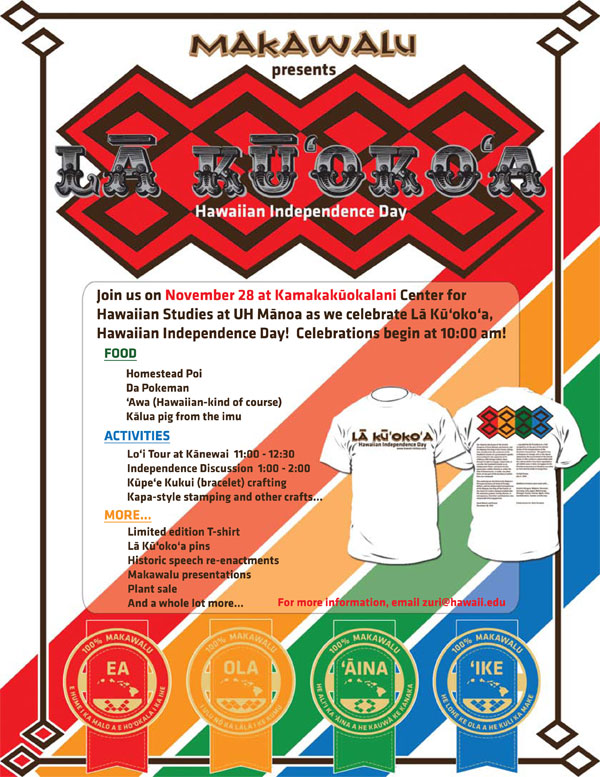From Leon Siu…
Ke Aupuni Update
November 27, 2011
Keeping in touch and updated on activities regarding the restoration of Ke Aupuni o Hawaii, the Hawaiian Kingdom. Ua mau ke ea o ka aina I ka pono.
Makawalu presents
Lā Kū’oko’a
Tomorrow, November 28, 2011 10am-2pm
at Kamakakūokalani Center for Hawaiian Studies
UH Mānoa
WHAT IS Lä KŪ’oko’a?
In the Kingdom of Hawai’i, November 28 was an official holiday called Lā Kū‘oko‘a, or Independence Day. This was the day in 1843 when England and France formally recognized Hawai’i’s independence.
Faced with the problem of foreign encroachment of Hawaiian territory, His Majesty King Kamehameha III deemed it prudent and necessary to dispatch a Hawaiian delegation to the United States and then to Europe, with the power to negotiate treaties and to ultimately secure the recognition of Hawaiian Independence by the major powers of the world.
In accordance with this view, Timoteo Ha‘alilio, William Richards and Sir George Simpson were commissioned as joint Ministers Plenipotentiary on April 8, 1842. Sir George Simpson, shortly thereafter, left for England, via Alaska and Siberia, while Mr. Ha‘alilio and Mr. Richards departed for the United States, via Mexico and the United States, on July 8, 1842.The Hawaiian delegation, while in the United States of America, secured the assurance of U.S. President Tyler on December 19, 1842 of its recognition of Hawaiian independence, and then proceeded to meet Sir George Simpson in Europe and secure formal recognition by Great Britain and France. On March 17, 1843, King Louis-Phillipe of France recognized Hawaiian independence at the urging of King Leopold of Belgium, and on April 1, 1843, Lord Aberdeen on behalf of Her Britannic Majesty Queen Victoria, assured the Hawaiian delegation that:
“Her Majesty’s Government was willing and had determined to recognize the independence of the Sandwich Islands under their present sovereign.”
Formal Agreement of Recognition
On November 28, 1843, at the Court of London, the British and French Governments entered into a formal agreement of the recognition of Hawaiian independence, with what is called the Anglo-Franco Proclamation.
To wit:
“Her Majesty the Queen of the United Kingdom of Great Britain and Ireland, and His Majesty the King of the French, taking into consideration the existence in the Sandwich Islands (Hawaiian Islands) of a government capable of providing for the regularity of its relations with foreign nations, have thought it right to engage, reciprocally, to consider the Sandwich Islands as an Independent State, and never to take possession, neither directly or under the title of Protectorate, or under any other form, of any part of the territory of which they are composed.
The undersigned, Her Majesty’s Principal Secretary of State of Foreign Affairs, and the Ambassador Extraordinary of His Majesty the King of the French, at the Court of London, being furnished with the necessary powers, hereby declare, in consequence, that their said Majesties take reciprocally that engagement.
In witness whereof the undersigned have signed the present declaration, and have affixed thereto the seal of their arms.Done in duplicate at London, the 28th day of November, in the year of our Lord, 1843.
[L.S.] Aberdeen [L.S.] St. Aulaire”
The Fake Revolution
Fifty years later, in 1893, an illegal intervention by the U.S. military resulted in a “fake revolution” against the legitimate Hawaiian government, and a puppet oligarchy set itself up with its main purpose of annexing Hawai‘i to the United States. After a failed armed attempt by Hawaiians to retake their Kingdom in 1895, the usurpers announced that Lā Kū‘oko‘a would no longer be celebrated, and the American holiday Thanksgiving Day would be the official national holiday instead. Removing a holiday like Hawai‘i Independence Day was a way to cover up and try to destroy the history and identity of the Hawaiian Kingdom and its people.
At first Hawaiians protested and celebrated Lā Kū‘oko‘a anyway, telling the story of the national heroes who had travelled to Europe to secure Hawaii’s recognition. But over time, this history — knowledge of the holiday and how it was replaced — faded and was almost lost, until recently, when Hawaiian language scholars started translating Hawaiian language newspapers and rediscovered the story.
Today’s celebration of Lā Kū‘oko‘a asserts that Hawai‘i is still an independent nation, even under prolonged illegal occupation.
[Initial text from Kalāhui Hawai‘iin UNPO publication]
Timoteo Ha‘alilio (1808—1844)
Ha‘alilio converted to Christianity as a young man, and remained a devout follower of Iesu Kristo all his life. Proficient in Hawaiian and English, he served as private secretary of King Kamehameha III, and as a member of the treasury board. As the minister plenipotentiary of the Hawaiian Kingdom, he led the diplomatic team that successfully secured formal recognition of the independence of the Hawaiian Kingdom. Timoteo Ha‘alilio passed away of tuberculosis on December 3, 1844 on the way back to the Hawaiian Islands.



There was no fake revolution but a coup d’état on January 17, 1893.
“By an act of war, committed with the participation of a diplomatic representative of the United States and without authority of Congress.
Due to admitted acts of insurgency, rebellion and the overthrow of the Constitutional
Monarchy of the Kingdom of Hawai’i, the de jure Nation is under a continued impairment and is
properly considered as an irregular state.
Im only posting this because proper language and definitions are crucial…..
Aloha kakahiaka,
Great site!
Any update on “2013” La Ku’oko’a Celebration?
malama, pilipo
I haven’t seen anything yet but will post as soon as I do.